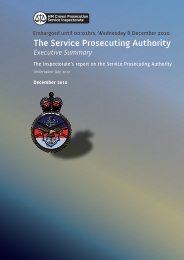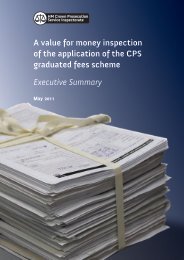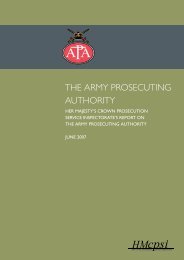Actions speak louder: A second review of healthcare in ... - HMCPSI
Actions speak louder: A second review of healthcare in ... - HMCPSI
Actions speak louder: A second review of healthcare in ... - HMCPSI
Create successful ePaper yourself
Turn your PDF publications into a flip-book with our unique Google optimized e-Paper software.
ACTIONS SPEAK LOUDER<br />
FINDINGS<br />
Of the children and young people whose cases our health <strong>in</strong>spectors looked at,<br />
nearly a quarter were assessed as hav<strong>in</strong>g some form <strong>of</strong> disability. Half <strong>of</strong> those<br />
related to a learn<strong>in</strong>g disability, a fifth had a physical impairment and the rest had<br />
a disability l<strong>in</strong>ked to their mental health or emotional state. In the total number<br />
<strong>of</strong> cases <strong>review</strong>ed by both health <strong>in</strong>spectors and Her Majesty’s Inspectorate <strong>of</strong><br />
Probation <strong>in</strong>spectors <strong>in</strong> phase 4, 17% were assessed as hav<strong>in</strong>g a disability with a<br />
quarter <strong>of</strong> those exhibit<strong>in</strong>g issues l<strong>in</strong>ked to their mental health or emotional state. 7<br />
A considerable number <strong>of</strong> children and young people display<strong>in</strong>g <strong>of</strong>fend<strong>in</strong>g behaviour<br />
therefore have identifiable health issues. The overall number, however, may be<br />
higher, s<strong>in</strong>ce we also found that many health needs were not be<strong>in</strong>g reliably<br />
assessed or, <strong>in</strong> the case <strong>of</strong> physical health, too <strong>of</strong>ten ignored.<br />
There is still a significant percentage <strong>of</strong> children and young people who are<br />
‘looked-after’ 8 who come <strong>in</strong>to contact with YOTs. Twelve per cent <strong>of</strong> all the children<br />
and young people (from a random sample) whose cases were <strong>in</strong>vestigated were<br />
either accommodated and ma<strong>in</strong>ta<strong>in</strong>ed via a care order, or remanded <strong>in</strong> local<br />
authority accommodation.<br />
In phase 4, we also considered what the nature <strong>of</strong> the orig<strong>in</strong>al <strong>of</strong>fence was <strong>of</strong> the<br />
young people whose cases we exam<strong>in</strong>ed. The highest percentage <strong>of</strong> the total (30%)<br />
related to violence aga<strong>in</strong>st the person, and the <strong>second</strong> highest (16%) <strong>in</strong>volved theft<br />
and handl<strong>in</strong>g stolen goods. Specific drug <strong>of</strong>fences amounted to 4% <strong>of</strong> the total while<br />
crim<strong>in</strong>al damage was 10% overall. For those children and young people with<br />
custodial sentences, the majority who had been released <strong>in</strong>to the community on<br />
community supervision had conditions, or an <strong>in</strong>tensive supervision and surveillance<br />
programme, attached to that order.<br />
Prevention<br />
In all cases relat<strong>in</strong>g to prevention <strong>in</strong> phase 4, there was evidence <strong>of</strong> specific physical<br />
health needs (scor<strong>in</strong>g above 3 us<strong>in</strong>g the YJB ‘Onset’ 9 ) <strong>in</strong> 15% <strong>of</strong> the cases. There was<br />
additional evidence <strong>of</strong> emotional and mental health needs <strong>in</strong> 50% <strong>of</strong> the cases and<br />
evidence <strong>of</strong> substance misuse needs <strong>in</strong> 15% <strong>of</strong> cases (out <strong>of</strong> 554 prevention cases<br />
provid<strong>in</strong>g relevant data for this analysis). Less than half <strong>of</strong> these cases were<br />
subsequently referred to ma<strong>in</strong>stream health services.<br />
The percentage <strong>of</strong> cases where there was evidence <strong>of</strong> an <strong>in</strong>tervention be<strong>in</strong>g<br />
delivered <strong>in</strong> relation to physical health only amounted to 9%; for emotional and<br />
mental health, the percentage was 26%; and for substance misuse, the percentage<br />
7<br />
This was from a total <strong>of</strong> 3,370 cases hav<strong>in</strong>g been exam<strong>in</strong>ed <strong>in</strong> <strong>in</strong>spections.<br />
8<br />
Those children and young people who are accommodated by a local authority.<br />
9<br />
Onset is a YJB assessment tool used for those who may <strong>of</strong>fend – the YJB <strong>in</strong>dicates that an assessment score <strong>of</strong><br />
3 or more should lead to a referral for a more thorough assessment by a specialist health worker. The scale is<br />
0-4 where 0 is not associated with the likelihood <strong>of</strong> <strong>of</strong>fend<strong>in</strong>g and 4 is very strongly associated with the likelihood<br />
<strong>of</strong> <strong>of</strong>fend<strong>in</strong>g.<br />
14








